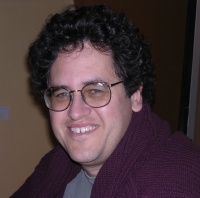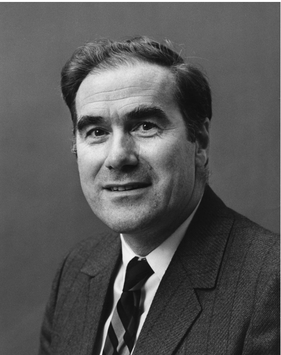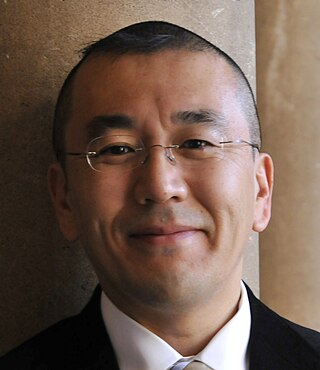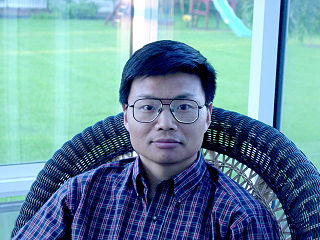Related Research Articles

John Carlos Baez is an American mathematical physicist and a professor of mathematics at the University of California, Riverside (UCR) in Riverside, California. He has worked on spin foams in loop quantum gravity, applications of higher categories to physics, and applied category theory. Additionally, Baez is known on the World Wide Web as the author of the crackpot index.

Frank Thomson "Tom" Leighton is the CEO of Akamai Technologies, the company he co-founded with the late Daniel Lewin in 1998. As one of the world's preeminent authorities on algorithms for network applications and cybersecurity, Leighton discovered a solution to free up web congestion using applied mathematics and distributed computing.

Roy Jay Glauber was an American theoretical physicist. He was the Mallinckrodt Professor of Physics at Harvard University and Adjunct Professor of Optical Sciences at the University of Arizona. Born in New York City, he was awarded one half of the 2005 Nobel Prize in Physics "for his contribution to the quantum theory of optical coherence", with the other half shared by John L. Hall and Theodor W. Hänsch. In this work, published in 1963, he created a model for photodetection and explained the fundamental characteristics of different types of light, such as laser light and light from light bulbs. His theories are widely used in the field of quantum optics. In statistical physics he pioneered the study of the dynamics of first-order phase transitions, since he first defined and investigated the stochastic dynamics of an Ising model in a paper published in 1963. He served on the National Advisory Board of the Center for Arms Control and Non-Proliferation, the research arms of Council for a Livable World.

Richard Alfred Tapia is an American mathematician and University Professor at Rice University in Houston, Texas, the university's highest academic title. In 2011, President Obama awarded Tapia the National Medal of Science. He is currently the Maxfield and Oshman Professor of Engineering; Associate Director of Graduate Studies, Office of Research and Graduate Studies; and Director of the Center for Excellence and Equity in Education at Rice University.

Kannan Soundararajan is an Indian-born American mathematician and a professor of mathematics at Stanford University. Before moving to Stanford in 2006, he was a faculty member at University of Michigan, where he had also pursued his undergraduate studies. His main research interest is in analytic number theory, particularly in the subfields of automorphic L-functions, and multiplicative number theory.
Luc Vinet is a Canadian physicist and mathematician. He was former rector of the Université de Montréal between 2005 and 2010. He is the CEO of IVADO, created in 2015 since August 2021.

Gerald Beresford Whitham FRS was a British–born American applied mathematician and the Charles Lee Powell Professor of Applied Mathematics (Emeritus) of Applied & Computational Mathematics at the California Institute of Technology. He received his Ph.D. from the University of Manchester in 1953 under the direction of Sir James Lighthill. He is known for his work in fluid dynamics and waves.
Chi-Wang Shu is the Theodore B. Stowell University Professor of Applied Mathematics at Brown University. He is known for his research in the fields of computational fluid dynamics, numerical solutions of conservation laws and Hamilton–Jacobi type equations. Shu has been listed as an ISI Highly Cited Author in Mathematics by the ISI Web of Knowledge.

Hirosi Ooguri is a theoretical physicist working on quantum field theory, quantum gravity, superstring theory, and their interfaces with mathematics. He is Fred Kavli Professor of Theoretical Physics and Mathematics and the Founding Director of the Walter Burke Institute for Theoretical Physics at California Institute of Technology. He is also the director of the Kavli Institute for the Physics and Mathematics at the University of Tokyo and is the chair of the board of trustees of the Aspen Center for Physics in Colorado.

Helge Holden is a Norwegian mathematician working in the field of differential equations and mathematical physics. He was Praeses of the Royal Norwegian Society of Sciences and Letters from 2014 to 2016.

Emmanuel Jean Candès is a French statistician most well known for his contributions to the field of Compressed sensing and Statistical hypothesis testing. He is a professor of statistics and electrical engineering at Stanford University, where he is also the Barnum-Simons Chair in Mathematics and Statistics. Candès is a 2017 MacArthur Fellow.
Nancy Jane Kopell is an American mathematician and professor at Boston University. She is co-director of the Center for Computational Neuroscience and Neural Technology (CompNet). She organized and directs the Cognitive Rhythms Collaborative (CRC). Kopell received her B.A. from Cornell University in 1963 and her Ph.D. from Berkeley in 1967. She held visiting positions at the Centre National de la Recherche Scientifique in France (1970), MIT, and the California Institute of Technology (1976).

Weinan E is a Chinese mathematician. He is known for his pathbreaking work in applied mathematics and machine learning. His academic contributions include novel mathematical and computational results in stochastic differential equations; design of efficient algorithms to compute multiscale and multiphysics problems, particularly those arising in fluid dynamics and chemistry; and pioneering work on the application of deep learning techniques to scientific computing. In addition, he has worked on multiscale modeling and the study of rare events.

Michel Xavier Goemans is a Belgian-American professor of applied mathematics and the RSA Professor of Mathematics at MIT working in discrete mathematics and combinatorial optimization at CSAIL and MIT Operations Research Center.

Miriam Cohen is an Israeli mathematician and a professor in the Department of Mathematics at Ben-Gurion University of the Negev whose main areas of research are Hopf algebras, quantum groups and Noncommutative rings.
Leonard J. Y. Schulman is professor of computer science in the Computing and Mathematical Sciences Department at the California Institute of Technology. He is known for work on algorithms, information theory, coding theory, and quantum computation.
Ruth Jeannette Williams is an Australian-born American mathematician at the University of California, San Diego where she holds the Charles Lee Powell Chair as a Distinguished Professor of Mathematics. Her research concerns probability theory and stochastic processes.
Igor Mezić is a mechanical engineer, mathematician, and Distinguished Professor of mechanical engineering and mathematics at the University of California, Santa Barbara. He is best known for his contributions to operator theoretic, data driven approach to dynamical systems theory that he advanced via articles based on Koopman operator theory, and his work on theory of mixing, that culminated in work on microfluidic mixer design, and mapping oil refuse from the Deepwater Horizon oil spill in the Gulf of Mexico to aid in cleaning efforts.

Kavita Ramanan is a probability theorist who works as a professor of applied mathematics at Brown University.
Rodrigo Bañuelos is an American mathematician and a professor of mathematics at Purdue University in West Lafayette, Indiana. His research is in probability and its applications to harmonic analysis and spectral theory.
References
- ↑ Porter, Mason. "personal CV" (PDF). Retrieved 2017-06-18.
- 1 2 "Mason A. Porter". aps.org. Retrieved April 24, 2017.
- 1 2 3 "Mason A. Porter". ucla.edu. Retrieved 2019-08-03.
- ↑ 2018 Class of the Fellows of the AMS, American Mathematical Society , retrieved 2017-11-03
- ↑ Mason Porter - Mathematics Genealogy Project, North Dakota State University , retrieved 2019-08-03
- ↑ ER Prize, NetSci Society, retrieved 2019-08-03
- ↑ 2018 Class of the Fellows of the AMS, American Mathematical Society , retrieved 2017-11-03
- ↑ "Call for Proposals". dpg.-physik.de. Retrieved August 3, 2019.
- ↑ "SIAM Fellows Class of 2019" . Retrieved 2019-09-01.
- ↑ Quantum Chaotic Thoughts, Mason Porter, retrieved 2019-08-03